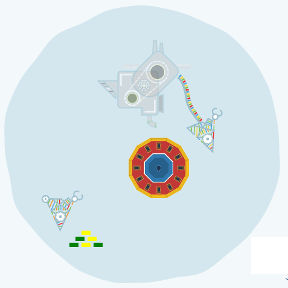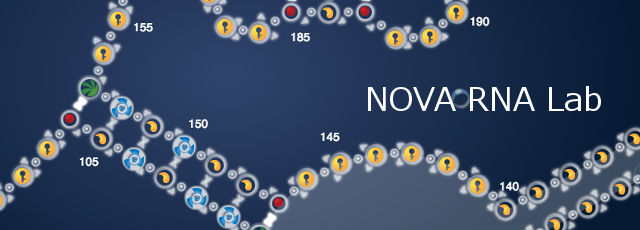![]() You know what's cool? Science, that's what. You know what's even cooler? Science games that can help save people's lives. As awesomely powerful as DNA is (see Play to Cure: Genes in Space for more on that), RNA is even more ancient and mysterious, and while we have a good understanding of how it works, there are so many ways it can fit together that we don't fully grasp the full range of things it can do. That's where the NOVA RNA Lab comes in. You don't need any special scientific knowledge to work in the VirtuaLab, as a wonderfully snarky computer guides you through the tutorial and the three subsequent pre-made worlds. Your goal in these early levels is to place the four RNA bases (adenine, guanine, uracil, and cytosine) so that your strand folds the same way as your goal image. Each bond and loop behaves differently, and there are different goals for each level. Once you complete the pre-made levels, the game becomes your toolbox, and you can not only build your own strands but vote on whose results actually end up being created in a real-life lab. If this sounds like Foldit or Eterna, that's because PBS teamed up with the people who made those games, and integrated a whole lot of improvements.
You know what's cool? Science, that's what. You know what's even cooler? Science games that can help save people's lives. As awesomely powerful as DNA is (see Play to Cure: Genes in Space for more on that), RNA is even more ancient and mysterious, and while we have a good understanding of how it works, there are so many ways it can fit together that we don't fully grasp the full range of things it can do. That's where the NOVA RNA Lab comes in. You don't need any special scientific knowledge to work in the VirtuaLab, as a wonderfully snarky computer guides you through the tutorial and the three subsequent pre-made worlds. Your goal in these early levels is to place the four RNA bases (adenine, guanine, uracil, and cytosine) so that your strand folds the same way as your goal image. Each bond and loop behaves differently, and there are different goals for each level. Once you complete the pre-made levels, the game becomes your toolbox, and you can not only build your own strands but vote on whose results actually end up being created in a real-life lab. If this sounds like Foldit or Eterna, that's because PBS teamed up with the people who made those games, and integrated a whole lot of improvements.
 The lab's interface makes it easy to learn to play. You can paint individual bases or pairs if you like, but it's much easier to just paint entire strips by clicking and dragging along the areas you want to paint. You can switch between "goal mode" (which lets you see what your goal shape is) and "natural mode (which shows how your RNA strand will actually fold). The palette where you choose your base pairs doubles as a cheat sheet for what bases form what kind of bonds, and there's a "hint" option that walks you through each level if you get stuck. All this is to prepare you for the full lab, where you can create your very own RNA strands. What do they do? Do they fold up as expected? The world can find out! And in the process, we can maybe discover a specific protein that could cure a disease, or figure out the exact origins of life on Earth. There's more information available on the history of this game and exactly how it works at PBS's website. In short, the lab is an engaging way to learn science and maybe change the world.
The lab's interface makes it easy to learn to play. You can paint individual bases or pairs if you like, but it's much easier to just paint entire strips by clicking and dragging along the areas you want to paint. You can switch between "goal mode" (which lets you see what your goal shape is) and "natural mode (which shows how your RNA strand will actually fold). The palette where you choose your base pairs doubles as a cheat sheet for what bases form what kind of bonds, and there's a "hint" option that walks you through each level if you get stuck. All this is to prepare you for the full lab, where you can create your very own RNA strands. What do they do? Do they fold up as expected? The world can find out! And in the process, we can maybe discover a specific protein that could cure a disease, or figure out the exact origins of life on Earth. There's more information available on the history of this game and exactly how it works at PBS's website. In short, the lab is an engaging way to learn science and maybe change the world.






When I need a reminder that the world isn't all horrible, I realize that Flash games can actually change the world for the better.
Fascinating stuff. If I understand correctly, scientists don't always know if the folding will work as predicted, but the math that determines how they THINK it will work is clearly pretty wild already. (No wonder it sometimes takes a few seconds of spinning disc to figure out the effect our changes will have!) A highlight for me just now was changing a single G-C bond in the middle of a stack to a U-G (out of 221 bases) and watching my entire stable design suddenly twist itself into a crazy pretzel. The rules are obviously far more complex than any tutorial could demonstrate, and so far I find it just a little hard to believe that we total RNA noobs could stumble upon a configuration that would lead to breakthroughs, but I'm willing to suspend disbelief and give it a shot.
This game is TOO BIG for my screen. It can't be properly shrunk with the rest of the browser page and I have to go into fullscreen mode to even see it properly. And then after each level it scrolls back up to the top of the screen and I can't see the buttons I have to press anymore. I'm playing it anyway because it's fun and for a good cause, but I wish game designers would stop making games unshrinkable and stop assuming that everyone who plays their games has big/high-res computer screens.
From the opposite perspective, I was annoyed that I couldn't make it take up my whole screen, rather than having to zoom out inside the game, or drag the molecule around :(
Update